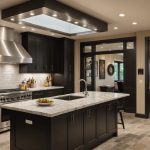Outdoor dining spaces can be transformed into vibrant attractions that captivate customers and elevate their experiences. Innovative design elements, creative layouts, and thoughtful use of lighting can create inviting atmospheres. Consider integrating greenery, art installations, or unique themes to enhance visual appeal. This approach not only attracts patrons but also encourages longer stays, boosting overall revenue. Discover how to reimagine outdoor dining areas to create unforgettable moments for your guests.
Understanding the Importance of Outdoor Dining Spaces
Outdoor dining has become a vital element in enhancing a restaurant's appeal. By offering an open-air environment, restaurants can attract more customers who are looking for a unique dining experience. This setting not only elevates the ambiance but also boosts customer satisfaction by providing a refreshing alternative to indoor dining.
This might interest you : Crafting a unique brew experience: your complete guide to introducing a boutique brewery and curating exclusive craft beers in your restaurant
A significant impact of outdoor dining is its potential to increase revenue. With more seating options, restaurants can accommodate a larger number of guests, especially during peak hours. This expansion can directly translate to higher sales and improved profitability. Moreover, diners often spend more time and money in an enjoyable outdoor setting.
Trends and Influences
The popularity of outdoor dining is driven by several trends. In recent years, there has been a growing preference for al fresco dining, partly due to health concerns and the desire for more spacious environments. Additionally, the integration of technology, such as outdoor heaters and weather-resistant furniture, has made it feasible to offer outdoor dining year-round.
This might interest you : Elevate your dining experience: expert tips for high-end restaurants to create a successful farm-to-table menu
- Benefits of outdoor dining:
- Enhanced customer experience
- Increased seating capacity
- Improved ambiance
Restaurants that embrace these trends and invest in appealing outdoor spaces can significantly enhance their appeal and customer experience, making them a preferred choice in the competitive dining industry.
Innovative Design Concepts for Outdoor Dining
Exploring creative approaches to enhance outdoor dining spaces.
Unique Layouts and Seating Arrangements
Outdoor dining design thrives on creativity, where unique layouts can transform spaces into captivating environments. Consider circular seating arrangements to foster a communal atmosphere, or staggered seating to offer privacy. Innovative designs can maximize space, ensuring comfort and functionality.
The Role of Color and Materials in Design
Colors and materials play a crucial role in defining a restaurant's aesthetics. Utilizing vibrant colors can create a lively atmosphere, while natural tones offer a calming effect. Materials like wood and stone add texture and warmth, enhancing the overall design. A harmonious blend of these elements can elevate the dining experience.
Incorporating Natural Elements into the Space
Integrating natural elements is essential in outdoor dining design. Incorporate greenery, such as vertical gardens or potted plants, to create a serene environment. Water features can add soothing sounds, while natural light enhances the ambiance. These elements not only beautify the space but also connect diners with nature.
- Creative ideas for outdoor design:
- Circular and staggered seating
- Vibrant and natural color schemes
- Use of greenery and water features
By focusing on these aspects, restaurants can craft inviting and functional outdoor spaces that align with modern aesthetics and customer expectations.
Successful Case Studies in Outdoor Dining Transformations
Exploring real-world examples of outdoor dining success stories.
Notable Restaurant Transformations
Several restaurants have undergone remarkable transformations by embracing outdoor dining. For instance, a well-known bistro in New York revamped its patio, incorporating heated lamps and retractable awnings. This transformation allowed year-round service, significantly boosting revenue and customer satisfaction. Another example is a coastal restaurant that integrated local flora into its outdoor space, enhancing the natural ambiance and drawing in more patrons.
Key Takeaways from Successful Implementations
These successful implementations highlight the importance of adaptability and creativity. Restaurants that effectively utilize outdoor spaces often see increased foot traffic and customer engagement. Key strategies include investing in weather-resistant furnishings and creating versatile layouts that can be adjusted based on weather conditions or special events.
Lessons Learned from Innovative Outdoor Spaces
Innovative outdoor spaces offer valuable lessons for other establishments. One critical lesson is the power of local culture in design. Restaurants that incorporate local elements into their outdoor areas tend to resonate more with their community. Additionally, maintaining a balance between aesthetics and functionality is crucial for sustaining long-term success.
- Key Strategies:
- Weather-resistant furnishings
- Versatile layouts
- Incorporation of local culture
By studying these case studies, restaurants can glean insights into creating appealing and profitable outdoor dining experiences.
Current Trends in Outdoor Dining Enhancement
Exploring the evolving landscape of outdoor dining.
Popular Design Trends in Outdoor Dining
The design evolution of outdoor dining spaces is marked by a shift towards more versatile and aesthetically pleasing environments. Restaurants are increasingly adopting modular furniture that can be easily rearranged to accommodate different group sizes and events. This flexibility allows for seamless transitions between seasons and varying customer preferences.
Seasonal Considerations for Outdoor Spaces
Adapting outdoor dining areas to seasonal changes is crucial for maintaining a consistent customer experience. Seasonal adaptations include installing retractable awnings for shade in summer and using heated lamps during colder months. Such measures ensure that outdoor spaces remain inviting and functional year-round.
- Key Seasonal Adaptations:
- Retractable awnings
- Heated lamps
- Weather-resistant materials
Technology Integration in Outdoor Dining
Technology integration has become a cornerstone of modern outdoor dining. Restaurants are implementing smart lighting and sound systems to enhance ambiance and create a personalized dining experience. Additionally, the use of weather-resistant tech, such as outdoor heaters and digital menus, supports the design evolution by offering practical solutions to common challenges.
By embracing these outdoor dining trends, restaurants can create dynamic spaces that cater to diverse customer needs, ensuring sustained appeal and profitability.
Tips for Optimizing Space in Outdoor Dining Areas
Creating an efficient outdoor layout is essential for maximizing the potential of dining areas. This process involves thoughtful space optimization to ensure comfort and functionality.
Maximizing Seating Capacity
Strategically arranging tables can significantly enhance seating capacity. Consider using narrow tables and benches that can accommodate more guests without compromising comfort. Functional design principles suggest utilizing corners and edges effectively to create additional seating options.
Flexible Furniture Options
Flexible furniture is critical for adapting to changing customer needs. Opt for lightweight, stackable chairs and modular tables that can be easily rearranged. This flexibility allows for quick transitions between different zoning arrangements, catering to varying group sizes and activities.
- Benefits of Flexible Furniture:
- Adaptability for events
- Ease of storage
- Cost-effective solutions
Zoning Outdoor Spaces
Zoning is a powerful tool for organizing outdoor areas. By designating specific zones for dining, lounging, and entertainment, restaurants can create a dynamic environment that caters to diverse activities. Use planters or screens to define these zones subtly, ensuring a seamless flow throughout the space.
Incorporating these strategies into the outdoor layout can lead to effective space optimization, enhancing both the dining experience and operational efficiency.
Essential Decor Elements for Outdoor Dining
Creating the perfect atmosphere for outdoor dining requires careful selection of decor.
Choosing the Right Decor Style
Selecting an appropriate decor style is crucial for establishing the desired ambiance in outdoor dining spaces. Restaurants should consider their overall theme and target audience when choosing decor. Whether opting for a rustic, modern, or eclectic style, the decor must complement the restaurant's identity and enhance the dining experience.
Importance of Seasonal and Thematic Decorations
Seasonal and thematic decorations play a significant role in maintaining a fresh and engaging ambiance. Incorporating elements that reflect the changing seasons or specific themes can keep the outdoor space vibrant and appealing. For instance, using fall foliage or spring blossoms can instantly transform the decor, making it more inviting.
Incorporating Local Art and Culture
Infusing local art and culture into outdoor decor can create a unique and memorable environment. By showcasing local artists' work or cultural motifs, restaurants can connect with their community and offer diners a distinct sense of place. This approach not only enhances the ambiance but also supports local talent.
- Key Decor Elements:
- Seasonal decorations
- Thematic accents
- Local art displays
Incorporating these elements into outdoor dining spaces can elevate the ambiance, making the restaurant a desirable destination.
The Role of Lighting in Outdoor Dining Experiences
Exploring the impact of lighting on outdoor dining.
Different Types of Lighting for Outdoor Spaces
Outdoor lighting is crucial in shaping the overall ambiance of dining areas. Various lighting types, such as string lights, lanterns, and LED fixtures, can be employed to create a captivating environment. Ambient lighting provides general illumination, while task lighting focuses on specific areas like tables and pathways. Accent lighting highlights architectural features and decor, adding layers to the visual appeal.
Creating a Welcoming Atmosphere Through Lighting
Lighting plays a pivotal role in crafting a welcoming atmosphere. Soft, warm lights can evoke a sense of coziness, encouraging diners to relax and enjoy their experience. Conversely, bright, cool lights are ideal for lively spaces, enhancing energy and vibrancy. The strategic use of outdoor lighting can transform an ordinary space into an inviting haven.
Safety and Functionality Considerations in Outdoor Lighting
Ensuring safety and functionality is paramount when designing outdoor lighting. Proper illumination of walkways and entrances prevents accidents and ensures easy navigation. Additionally, energy-efficient options like solar-powered lights and motion sensors can optimize functionality while reducing costs. By balancing aesthetics with practicality, restaurants can enhance both the customer experience and operational efficiency.
- Key Considerations:
- Ambient, task, and accent lighting
- Warm vs. cool light tones
- Energy-efficient solutions
Incorporating these elements ensures a safe, functional, and aesthetically pleasing outdoor dining environment.
Landscaping Ideas to Enhance Outdoor Dining Areas
Exploring ways to integrate nature into dining spaces.
Selecting Appropriate Plants for Outdoor Dining
Choosing the right plants is essential for creating a welcoming outdoor dining environment. Opt for low-maintenance, hardy species that thrive in your local climate. Consider using greenery such as potted herbs or flowering shrubs to add color and fragrance. These plants not only beautify the space but also contribute to a refreshing dining experience.
Incorporating Hardscaping Elements
Hardscaping elements like stone paths, wooden decks, and decorative gravel can enhance the structure and functionality of outdoor dining areas. These features provide a stable and attractive foundation for seating arrangements. Integrating hardscaping with greenery creates a balanced aesthetic, offering both visual appeal and practicality.
Benefits of Greenery for Enhancing Customer Experience
Integrating greenery into outdoor dining spaces offers numerous benefits. It improves air quality, provides natural shade, and creates a calming atmosphere that enhances the overall customer experience. The presence of plants can also make spaces feel more private and intimate, encouraging diners to linger longer.
- Key Landscaping Elements:
- Low-maintenance plants
- Stone and wood features
- Privacy-enhancing greenery
By carefully selecting plants and incorporating hardscaping elements, restaurants can create outdoor dining environments that are both beautiful and functional, aligning with modern aesthetics and customer expectations.
Marketing Outdoor Dining Spaces Effectively
Crafting strategies to captivate and engage customers.
Leveraging Social Media
In the realm of outdoor dining marketing, social media platforms serve as powerful tools for customer outreach. By sharing visually appealing images and engaging stories of outdoor spaces, restaurants can attract potential diners. Regular updates about special events and seasonal offerings can keep the audience engaged. Leveraging platforms like Instagram and Facebook allows restaurants to showcase their ambiance and unique dining experiences effectively.
Promoting Special Events and Seasonal Offerings
Hosting special events tailored to the season can enhance outdoor dining marketing efforts. Events such as live music nights or seasonal tasting menus can draw in crowds and create buzz. Promoting these through targeted promotional strategies ensures that the information reaches the right audience, maximizing attendance and customer satisfaction.
Collaborating with Influencers and Local Businesses
Collaborations with local influencers and businesses can amplify customer outreach. Influencers can share their experiences, offering authentic endorsements that resonate with their followers. Partnering with local businesses for joint promotions can expand reach and foster community ties. This approach not only strengthens promotional strategies but also builds a network of support within the local area.
- Key Strategies:
- Social media engagement
- Seasonal event promotion
- Influencer collaborations
By focusing on these elements, restaurants can enhance their outdoor dining marketing and effectively reach their target audience.
Evaluating Customer Feedback on Outdoor Dining Enhancements
Understanding customer perspectives is crucial for optimizing outdoor dining spaces. Collecting customer feedback can be achieved through various methods, including surveys, comment cards, and digital platforms. These tools enable restaurants to gather insights into customer preferences and experiences.
Methods for Collecting Customer Feedback
Customer feedback collection can be streamlined using online surveys and social media polls. These methods offer convenience and reach a broad audience, providing valuable data on outdoor dining experiences. Additionally, in-person interviews and feedback forms at the restaurant can capture immediate reactions and suggestions.
Analyzing Feedback to Inform Design Changes
Analyzing customer feedback involves identifying patterns and common themes that highlight areas for improvement. By focusing on frequent comments and suggestions, restaurants can make informed decisions about design changes. For instance, feedback on seating comfort or lighting can guide enhancements that elevate the dining experience.
Continuous Improvement Strategies for Outdoor Dining Spaces
Implementing a continuous improvement approach ensures that outdoor dining spaces remain appealing and functional. Regularly revisiting customer feedback allows restaurants to adapt to changing preferences and trends. Establishing a feedback loop, where changes are communicated back to customers, fosters trust and engagement.
- Key Strategies:
- Utilize online and in-person feedback tools
- Focus on common themes for design changes
- Establish a feedback loop for continuous improvement
By prioritizing customer feedback, restaurants can create dynamic, customer-focused outdoor dining environments.











